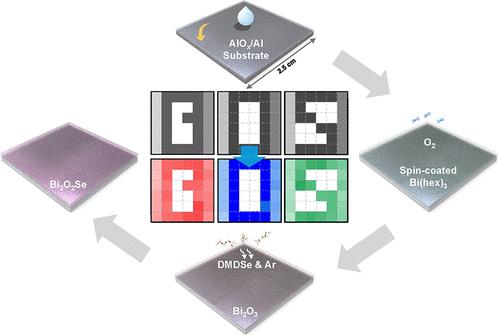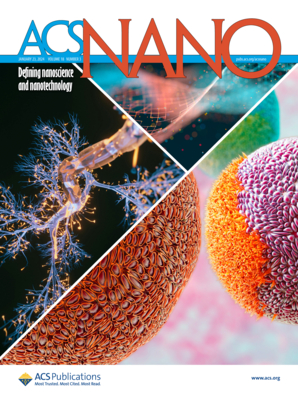Low-Temperature Chemical Solution Deposition of Bi2O2Se on Amorphous Surface for Dynamic Memristor of Physical Reservoir Array
IF 15.8
1区 材料科学
Q1 CHEMISTRY, MULTIDISCIPLINARY
引用次数: 0
Abstract
Bismuth oxyselenide (Bi2O2Se) stands as a highly promising layered semiconductor with outstanding optical, electrical, and thermal properties. For the practical application of the material toward the devices, growing Bi2O2Se directly on the amorphous substrate at low temperatures (<400 °C) is essential; however, the negatively charged bottom Se layer originating from alternating stacks of Se2– and [Bi2O2]2+ has hindered this process. In this work, we report the method for synthesizing a Bi2O2Se film on amorphous alumina (AlOx) directly at 350 °C by using chemical solution deposition. Our key strategy is to enhance the wettability of bismuth precursor solutions with the oxide first and then to selenize Bi2O3 in the gas phase. CSD-grown Bi2O2Se at 350 °C shows a uniform crystalline quality and chemical stoichiometry. Furthermore, we explore the applicability of Bi2O2Se toward dynamic memristors of a physical reservoir of reservoir computing systems. The fabricated Ag/Bi2O2Se/AlOx/Al-stacked dynamic memristors exhibit volatile memory properties, showing reasonable cycle-to-cycle and device-to-device variations that ensure reliability of the device operation. Intriguingly, the devices show programmable decay time in the range of microseconds to milliseconds depending on the pulse widths of different scales. Our work reveals an approach to grow Bi2O2Se films on versatile substrates that have great potential for future electronics, especially for low-temperature memristive applications.

求助全文
约1分钟内获得全文
求助全文
来源期刊

ACS Nano
工程技术-材料科学:综合
CiteScore
26.00
自引率
4.10%
发文量
1627
审稿时长
1.7 months
期刊介绍:
ACS Nano, published monthly, serves as an international forum for comprehensive articles on nanoscience and nanotechnology research at the intersections of chemistry, biology, materials science, physics, and engineering. The journal fosters communication among scientists in these communities, facilitating collaboration, new research opportunities, and advancements through discoveries. ACS Nano covers synthesis, assembly, characterization, theory, and simulation of nanostructures, nanobiotechnology, nanofabrication, methods and tools for nanoscience and nanotechnology, and self- and directed-assembly. Alongside original research articles, it offers thorough reviews, perspectives on cutting-edge research, and discussions envisioning the future of nanoscience and nanotechnology.
 求助内容:
求助内容: 应助结果提醒方式:
应助结果提醒方式:


